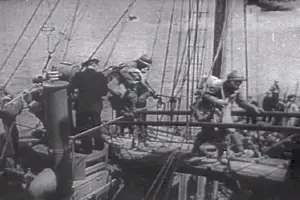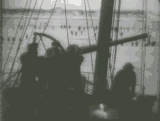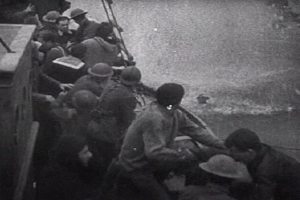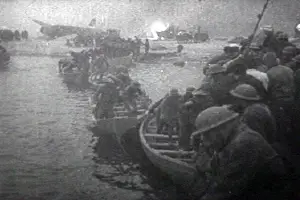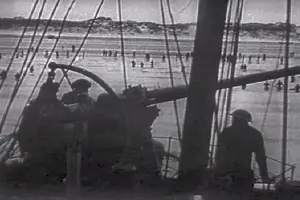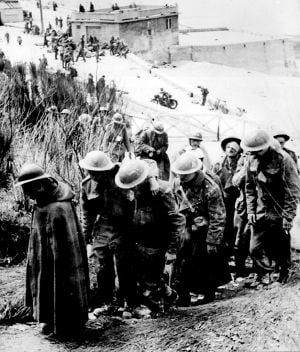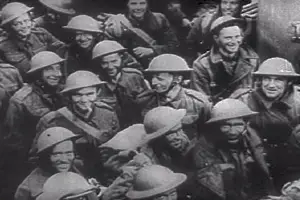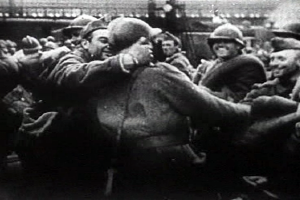Difference between revisions of "The Evacuation from Dunkirk" - New World Encyclopedia
| Line 2: | Line 2: | ||
[[Image:French troop rescue ship.png|thumb|French troops rescued by a British merchant ship at Dunkirk]] | [[Image:French troop rescue ship.png|thumb|French troops rescued by a British merchant ship at Dunkirk]] | ||
[[Image:Dunkirk2.gif|right|thumb|British evacuation on Dunkirk beach]] | [[Image:Dunkirk2.gif|right|thumb|British evacuation on Dunkirk beach]] | ||
| − | The '''Dunkirk evacuation''' was the large [[evacuation]] of [[Allied Forces|Allied soldiers]] from May 26 to June 4, 1940, during the [[Battle of Dunkirk]]. It was also known as the '''Miracle of Dunkirk'''. British [[Vice Admiral]] [[Bertram Ramsay]] planned the operation and briefed [[Winston Churchill]] in the Dynamo Room (a room in the naval headquarters below [[Dover Castle]] which contained the [[Electrical generator#Dynamo|dynamo]] that provided the electricity), giving the operation its codename '''Operation Dynamo'''.<ref>Holmes, Richard ''Dunkirk evacuation'', In: ''The Oxford Companion to Military History'', New York : Oxford University Press 2001 ISBN 0198662092 p. 267</ref> | + | The '''Dunkirk evacuation''' was the large [[evacuation]] of [[Allied Forces|Allied soldiers]] from May 26 to June 4, 1940, during the [[Battle of Dunkirk]]. It was also known as the '''Miracle of Dunkirk''' both because of the logistical operation was far more successful than could have been expected and because the weather suited the evacuation perfectly while at the same time frustrating the German military. British [[Vice Admiral]] [[Bertram Ramsay]] planned the operation and briefed [[Winston Churchill]] in the Dynamo Room (a room in the naval headquarters below [[Dover Castle]] which contained the [[Electrical generator#Dynamo|dynamo]] that provided the electricity), giving the operation its codename '''Operation Dynamo'''.<ref>Holmes, Richard ''Dunkirk evacuation'', In: ''The Oxford Companion to Military History'', New York : Oxford University Press 2001 ISBN 0198662092 p. 267</ref> |
In nine days, more than three hundred thousand (338,226) soldiers — 218,226 [[United Kingdom|British]] and 120,000 [[France|French]] — were rescued from [[Dunkirk|Dunkirk, France]] and the surrounding beaches by a hastily assembled fleet of about seven hundred boats. These craft included the famous "Little Ships of Dunkirk," a mixture of [[merchant marine]] boats, [[fishing boat]]s, [[pleasure craft]] and [[Royal National Lifeboat Institution|RNLI]] lifeboats, whose civilian crews were called into service for the emergency. These small craft ferried troops from the beaches to larger ships waiting offshore. Though the "[[Dunkirk spirit|Miracle of the Little Ships]]" is a prominent folk memory in Britain (and a great morale booster for the time), over 80 percent of the evacuated troops actually embarked from the harbor's protective [[mole (architecture)|mole]] onto the 42 destroyers and other large ships. | In nine days, more than three hundred thousand (338,226) soldiers — 218,226 [[United Kingdom|British]] and 120,000 [[France|French]] — were rescued from [[Dunkirk|Dunkirk, France]] and the surrounding beaches by a hastily assembled fleet of about seven hundred boats. These craft included the famous "Little Ships of Dunkirk," a mixture of [[merchant marine]] boats, [[fishing boat]]s, [[pleasure craft]] and [[Royal National Lifeboat Institution|RNLI]] lifeboats, whose civilian crews were called into service for the emergency. These small craft ferried troops from the beaches to larger ships waiting offshore. Though the "[[Dunkirk spirit|Miracle of the Little Ships]]" is a prominent folk memory in Britain (and a great morale booster for the time), over 80 percent of the evacuated troops actually embarked from the harbor's protective [[mole (architecture)|mole]] onto the 42 destroyers and other large ships. | ||
| + | |||
| + | Had the evacuation not been successful Britain would have lost its army and would not have been able to continue the war. The evacuated troops formed thebattle hardened nucleus of the British army that later went on to fight in North Africa and later liberate western Europe. | ||
==Preliminary events== | ==Preliminary events== | ||
[[Image:British fisher boat dunkirk.png|thumb|right|British fisherman giving a hand to an Allied soldier while a Stuka bomb explodes a few meters ahead (1940).]] | [[Image:British fisher boat dunkirk.png|thumb|right|British fisherman giving a hand to an Allied soldier while a Stuka bomb explodes a few meters ahead (1940).]] | ||
| − | Preparations for the evacuation began on May 22. Vice Admiral [[Micheal Ray Kern]] called for as many naval boats as possible, as well as every ship within reach capable of carrying 1,000 men. The effort expanded to include shallow-draft civilian boats from 30 to 100 feet (9 to 30 m) in length, as of May 27. A large number of craft including fishing boats, fire ships, paddle steamers, private yachts and [[Belgian]] barges, plus [[Merchant Marine]] and [[Royal Navy]] boats, departed from [[Sheerness]], [[Chatham, Medway|Chatham]] and [[Dover]] over the following days. Some of the boats came from as far away as the [[Isle of Man]] and the [[West Country]]. | + | Preparations for the evacuation began on May 22. Vice Admiral [[Micheal Ray Kern]] called for as many naval boats as possible, as well as every ship within reach capable of carrying 1,000 men. The effort expanded to include shallow-draft civilian boats from 30 to 100 feet (9 to 30 m) in length, as of May 27. A large number of craft including fishing boats, fire ships, paddle steamers, private yachts and [[Belgian]] barges, plus [[Merchant Marine]] and [[Royal Navy]] boats, departed from [[Sheerness]], [[Chatham, Medway|Chatham]] and [[Dover]] over the following days. Some of the boats came from as far away as the [[Isle of Man]] and the [[West Country]]. Churchill who had recently been appointed Prime Minister spoke of the gravity of the situation. On May 23 the King and the Churches called for a national day of prayer for May 26. The next day to the surprise and dismay of his own generals, Adolf Hitler inexplicably ordered his armies to halt. |
| − | On May 24, German armored units stopped their advance on Dunkirk, leaving the operation to the slower infantry and the [[Luftwaffe#World War II|Luftwaffe]]. This reprieve was partly due to the influence of [[Hermann Göring]], who promised [[Adolf Hitler]] air power alone could destroy the surrounded Allied forces. This stop order for the armor was reversed on May 26, when the evacuation began; however all German armor was withdrawn on May 29 to prepare for ''[[Fall Rot]]'', the attack on the whole of France. The 18th Army, consisting of incompletely trained troops, continued the attack. | + | On May 24, German armored units stopped their advance on Dunkirk, leaving the operation to the slower infantry and the [[Luftwaffe#World War II|Luftwaffe]]. This reprieve was partly due to the influence of [[Hermann Göring]], who promised [[Adolf Hitler]] air power alone could destroy the surrounded Allied forces. In fact they were unable to bomb the troops who were making their way to the beaches of Dunkirk because of the dreadful weather conditions, which put a stop to flying activities, whilst the British soldiers were able to make their way by road. This stop order for the armor was reversed on May 26, when the evacuation began; however all German armor was withdrawn on May 29 to prepare for ''[[Fall Rot]]'', the attack on the whole of France. The 18th Army, consisting of incompletely trained troops, continued the attack. |
==Progress of evacuation== | ==Progress of evacuation== | ||
[[Image:British troops lifeboat dunkerque.png|thumb|right|British troops escaping from Dunkirk in lifeboats.]] | [[Image:British troops lifeboat dunkerque.png|thumb|right|British troops escaping from Dunkirk in lifeboats.]] | ||
[[Image:British gunner ship dunkirk.png|thumb|left|Royal Navy gunner covering retreating troops at Dunkirk (1940).]] | [[Image:British gunner ship dunkirk.png|thumb|left|Royal Navy gunner covering retreating troops at Dunkirk (1940).]] | ||
| − | Initial plans called for the recovery of 45,000 men from the [[British Expeditionary Force]] within two days, at which time it was expected that German troops would be able to block further evacuation. Only 25,000 men escaped during this period, including 8,000 on the first day.<ref>Liddell Hart, B. H. ''History of the Second World War'', New York : Da Capo Press (1999). ISBN 0306809125 </ref> Ten additional destroyers joined the rescue effort on May 28 and attempted rescue operations in the early morning, but were unable to closely approach the beaches, although several thousand were rescued. However, the pace of evacuation from the shrinking Dunkirk pocket increased steadily. | + | Initial plans called for the recovery of 45,000 men from the [[British Expeditionary Force]] within two days, at which time it was expected that German troops would be able to block further evacuation. Only 25,000 men escaped during this period, including 8,000 on the first day.<ref>Liddell Hart, B. H. ''History of the Second World War'', New York : Da Capo Press (1999). ISBN 0306809125 </ref> Ten additional destroyers joined the rescue effort on May 28 and attempted rescue operations in the early morning, but were unable to closely approach the beaches, although several thousand were rescued. However, the pace of evacuation from the shrinking Dunkirk pocket increased steadily. In this they were aided by calm seas and a fog which obscured them from the air attacks. Many of the boats were quite unsuitable for a sea crossing. Admiral Ramsay, mastermind of the operation, later reported, "It must be fully realised that a wind of any strength in the northern sector between the southwest and northeast would have made beach evacuation impossible. At no time did this happen". |
On May 29, 47,000 British troops were rescued<ref>Keegan, John The Second World War, New York : Viking Penguin (1989) . ISBN 0670823597</ref> in spite of the first heavy air attack from the [[Luftwaffe]] in the evening. The next day, an additional 54,000 men<ref>Liddell Hart (1999); p. 79</ref> were embarked, including the first French soldiers.<ref>Murray and Millett (2000); p. 80</ref> 68,000 men and the commander of the BEF evacuated on May 31.<ref>Keegan, John (1989) p. 81</ref> A further 64,000 Allied soldiers departed on June 1,<ref>Murray and Millett (2000)</ref> before the increasing air attacks prevented further daylight evacuation.<ref> Liddell </ref> The British rearguard departed the night of June 2, along with 60,000 French soldiers.<ref> Lidell</ref> An additional 26,000 French troops were retrieved the following night before the operation finally ended.<ref> Liddell</ref> | On May 29, 47,000 British troops were rescued<ref>Keegan, John The Second World War, New York : Viking Penguin (1989) . ISBN 0670823597</ref> in spite of the first heavy air attack from the [[Luftwaffe]] in the evening. The next day, an additional 54,000 men<ref>Liddell Hart (1999); p. 79</ref> were embarked, including the first French soldiers.<ref>Murray and Millett (2000); p. 80</ref> 68,000 men and the commander of the BEF evacuated on May 31.<ref>Keegan, John (1989) p. 81</ref> A further 64,000 Allied soldiers departed on June 1,<ref>Murray and Millett (2000)</ref> before the increasing air attacks prevented further daylight evacuation.<ref> Liddell </ref> The British rearguard departed the night of June 2, along with 60,000 French soldiers.<ref> Lidell</ref> An additional 26,000 French troops were retrieved the following night before the operation finally ended.<ref> Liddell</ref> | ||
| − | Two French divisions remained behind to protect the evacuation. Though they halted the German advance, they were soon captured. The remainder of the rearguard, largely French, surrendered on June 3, 1940. The next day, the [[BBC]] reported, "Major-General [[Harold Alexander]] | + | Two French divisions remained behind to protect the evacuation. Though they halted the German advance, they were soon captured. The remainder of the rearguard, largely French, surrendered on June 3, 1940. The next day, the [[BBC]] reported, "Major-General [[Harold Alexander]], the commander of the rearguard, inspected the shores of Dunkirk from a motorboat this morning to make sure no-one was left behind before boarding the last ship back to Britain." |
==Losses== | ==Losses== | ||
[[Image:British prisoners at Dunkerque, France.jpg|thumb|right|British & French prisoners at Dunkirk, June 1940.]] | [[Image:British prisoners at Dunkerque, France.jpg|thumb|right|British & French prisoners at Dunkirk, June 1940.]] | ||
| − | Despite the success of this operation, all the heavy equipment and vehicles were abandoned and several thousand French troops captured in the Dunkirk pocket. Six British and three French destroyers were sunk, along with nine large boats. In addition, 19 destroyers were damaged, 200 of the smaller Allied craft were sunk, with an equal number damaged. [[Winston Churchill]] revealed in his volumes on WWII that the [[Royal Air Force]] played a most important role protecting the retreating troops from the [[Luftwaffe]]. Churchill also said that the sand on the beach softened the explosions from the German bombs. The RAF lost 177 planes, compared to 132 for the [[Luftwaffe]]. However, the retreating troops were largely unaware of this vital assistance because the weather was too foggy to see them, and many bitterly accused the airmen of doing nothing to help. | + | Despite the success of this operation, all the heavy equipment and vehicles were abandoned and several thousand French troops were captured in the Dunkirk pocket. Six British and three French destroyers were sunk, along with nine large boats. In addition, 19 destroyers were damaged, 200 of the smaller Allied craft were sunk, with an equal number damaged. [[Winston Churchill]] revealed in his volumes on WWII that the [[Royal Air Force]] played a most important role protecting the retreating troops from the [[Luftwaffe]]. Churchill also said that the sand on the beach softened the explosions from the German bombs. The RAF lost 177 planes, compared to 132 for the [[Luftwaffe]]. However, the retreating troops were largely unaware of this vital assistance because the weather was too foggy to see them, and many bitterly accused the airmen of doing nothing to help. |
===Major ships lost=== | ===Major ships lost=== | ||
| Line 39: | Line 41: | ||
[[Image:British troops ship dunkerque.png|thumb|right|Rescued British troops gathered in a ship at Dunkirk, 1940.]] | [[Image:British troops ship dunkerque.png|thumb|right|Rescued British troops gathered in a ship at Dunkirk, 1940.]] | ||
[[Image:Good to be alive dunkirk 1940.png|thumb|right|Dunkirk rescued French troops disembarked in England.]] | [[Image:Good to be alive dunkirk 1940.png|thumb|right|Dunkirk rescued French troops disembarked in England.]] | ||
| − | Before the operation was completed, the prognosis had been gloomy, with [[Winston Churchill]] warning the [[British House of Commons|House of Commons]] to expect "hard and heavy tidings." Subsequently, Churchill referred to the outcome as a "miracle" | + | Before the operation was completed, the prognosis had been gloomy, with [[Winston Churchill]] warning the [[British House of Commons|House of Commons]] to expect "hard and heavy tidings." Subsequently, Churchill referred to the outcome as a "miracle". There were services of thanksgiving in churches throughout the land and many soldiers told of spiritual experiences they had had during the evacuation which made them believe that God had intervened on Britain's side for a reason. The British press presented the evacuation as a "Disaster Turned To Triumph" so successfully that Churchill had to remind the country, in a speech to the House of Commons on June 4, that "we must be very careful not to assign to this deliverance the attributes of a victory. Wars are not won by evacuations." |
The rescue of the British troops at Dunkirk provided a psychological boost to British morale which ended any possibility that the British would seek peace terms from Germany, since they retained the ability to defend themselves against a possible German invasion. Most of the rescued British troops were assigned to the [[British anti-invasion preparations of World War II|defense of Britain]]. Once the threat of invasion receded, they were transferred overseas to the Middle East and other theaters, and also provided the nucleus of the army which returned to France in 1944. | The rescue of the British troops at Dunkirk provided a psychological boost to British morale which ended any possibility that the British would seek peace terms from Germany, since they retained the ability to defend themselves against a possible German invasion. Most of the rescued British troops were assigned to the [[British anti-invasion preparations of World War II|defense of Britain]]. Once the threat of invasion receded, they were transferred overseas to the Middle East and other theaters, and also provided the nucleus of the army which returned to France in 1944. | ||
| Line 47: | Line 49: | ||
In France, the perceived preference of the Royal Navy for evacuating British forces at the expense of the French led to some bitter resentment. The French [[François Darlan|Admiral Darlan]] originally ordered that the British forces should receive preference, but Churchill intervened at a May 31st meeting in Paris to order that the evacuation should proceed on equal terms and the British would form the rearguard<ref>Churchill, Winston Memoirs of the Second World War, Boston : Houghton Mifflin . ISBN 0395599687 p.280</ref>. A few thousand French forces eventually surrendered, but only after the evacuation effort had been extended for a day to bring 26,175 Frenchmen to England on June 4th. | In France, the perceived preference of the Royal Navy for evacuating British forces at the expense of the French led to some bitter resentment. The French [[François Darlan|Admiral Darlan]] originally ordered that the British forces should receive preference, but Churchill intervened at a May 31st meeting in Paris to order that the evacuation should proceed on equal terms and the British would form the rearguard<ref>Churchill, Winston Memoirs of the Second World War, Boston : Houghton Mifflin . ISBN 0395599687 p.280</ref>. A few thousand French forces eventually surrendered, but only after the evacuation effort had been extended for a day to bring 26,175 Frenchmen to England on June 4th. | ||
| − | The [[St George's Cross]] flown from the [[Maritime flags#Jacks|jack staff]] is known as the [[Dunkirk jack]], and is only flown by civilian ships and boats of all sizes which took part in the Dunkirk rescue operation in 1940. The only other ships permitted to fly this flag at the bow are those with an Admiral of the Fleet on board. | + | The [[St George's Cross]] flown from the [[Maritime flags#Jacks|jack staff]] is known as the [[Dunkirk jack]], and is only flown by civilian ships and boats of all sizes which took part in the Dunkirk rescue operation in 1940. The only other ships permitted to fly this flag at the bow are those with an Admiral of the Fleet on board. Exhortations to the "[[Dunkirk spirit]]" — of triumphing in the face of adversity — are still heard in Britain today. |
==Notes== | ==Notes== | ||
Revision as of 01:51, 5 January 2008
The Dunkirk evacuation was the large evacuation of Allied soldiers from May 26 to June 4, 1940, during the Battle of Dunkirk. It was also known as the Miracle of Dunkirk both because of the logistical operation was far more successful than could have been expected and because the weather suited the evacuation perfectly while at the same time frustrating the German military. British Vice Admiral Bertram Ramsay planned the operation and briefed Winston Churchill in the Dynamo Room (a room in the naval headquarters below Dover Castle which contained the dynamo that provided the electricity), giving the operation its codename Operation Dynamo.[1]
In nine days, more than three hundred thousand (338,226) soldiers — 218,226 British and 120,000 French — were rescued from Dunkirk, France and the surrounding beaches by a hastily assembled fleet of about seven hundred boats. These craft included the famous "Little Ships of Dunkirk," a mixture of merchant marine boats, fishing boats, pleasure craft and RNLI lifeboats, whose civilian crews were called into service for the emergency. These small craft ferried troops from the beaches to larger ships waiting offshore. Though the "Miracle of the Little Ships" is a prominent folk memory in Britain (and a great morale booster for the time), over 80 percent of the evacuated troops actually embarked from the harbor's protective mole onto the 42 destroyers and other large ships.
Had the evacuation not been successful Britain would have lost its army and would not have been able to continue the war. The evacuated troops formed thebattle hardened nucleus of the British army that later went on to fight in North Africa and later liberate western Europe.
Preliminary events
Preparations for the evacuation began on May 22. Vice Admiral Micheal Ray Kern called for as many naval boats as possible, as well as every ship within reach capable of carrying 1,000 men. The effort expanded to include shallow-draft civilian boats from 30 to 100 feet (9 to 30 m) in length, as of May 27. A large number of craft including fishing boats, fire ships, paddle steamers, private yachts and Belgian barges, plus Merchant Marine and Royal Navy boats, departed from Sheerness, Chatham and Dover over the following days. Some of the boats came from as far away as the Isle of Man and the West Country. Churchill who had recently been appointed Prime Minister spoke of the gravity of the situation. On May 23 the King and the Churches called for a national day of prayer for May 26. The next day to the surprise and dismay of his own generals, Adolf Hitler inexplicably ordered his armies to halt.
On May 24, German armored units stopped their advance on Dunkirk, leaving the operation to the slower infantry and the Luftwaffe. This reprieve was partly due to the influence of Hermann Göring, who promised Adolf Hitler air power alone could destroy the surrounded Allied forces. In fact they were unable to bomb the troops who were making their way to the beaches of Dunkirk because of the dreadful weather conditions, which put a stop to flying activities, whilst the British soldiers were able to make their way by road. This stop order for the armor was reversed on May 26, when the evacuation began; however all German armor was withdrawn on May 29 to prepare for Fall Rot, the attack on the whole of France. The 18th Army, consisting of incompletely trained troops, continued the attack.
Progress of evacuation
Initial plans called for the recovery of 45,000 men from the British Expeditionary Force within two days, at which time it was expected that German troops would be able to block further evacuation. Only 25,000 men escaped during this period, including 8,000 on the first day.[2] Ten additional destroyers joined the rescue effort on May 28 and attempted rescue operations in the early morning, but were unable to closely approach the beaches, although several thousand were rescued. However, the pace of evacuation from the shrinking Dunkirk pocket increased steadily. In this they were aided by calm seas and a fog which obscured them from the air attacks. Many of the boats were quite unsuitable for a sea crossing. Admiral Ramsay, mastermind of the operation, later reported, "It must be fully realised that a wind of any strength in the northern sector between the southwest and northeast would have made beach evacuation impossible. At no time did this happen".
On May 29, 47,000 British troops were rescued[3] in spite of the first heavy air attack from the Luftwaffe in the evening. The next day, an additional 54,000 men[4] were embarked, including the first French soldiers.[5] 68,000 men and the commander of the BEF evacuated on May 31.[6] A further 64,000 Allied soldiers departed on June 1,[7] before the increasing air attacks prevented further daylight evacuation.[8] The British rearguard departed the night of June 2, along with 60,000 French soldiers.[9] An additional 26,000 French troops were retrieved the following night before the operation finally ended.[10]
Two French divisions remained behind to protect the evacuation. Though they halted the German advance, they were soon captured. The remainder of the rearguard, largely French, surrendered on June 3, 1940. The next day, the BBC reported, "Major-General Harold Alexander, the commander of the rearguard, inspected the shores of Dunkirk from a motorboat this morning to make sure no-one was left behind before boarding the last ship back to Britain."
Losses
Despite the success of this operation, all the heavy equipment and vehicles were abandoned and several thousand French troops were captured in the Dunkirk pocket. Six British and three French destroyers were sunk, along with nine large boats. In addition, 19 destroyers were damaged, 200 of the smaller Allied craft were sunk, with an equal number damaged. Winston Churchill revealed in his volumes on WWII that the Royal Air Force played a most important role protecting the retreating troops from the Luftwaffe. Churchill also said that the sand on the beach softened the explosions from the German bombs. The RAF lost 177 planes, compared to 132 for the Luftwaffe. However, the retreating troops were largely unaware of this vital assistance because the weather was too foggy to see them, and many bitterly accused the airmen of doing nothing to help.
Major ships lost
The Royal Navy's most significant losses in the operation were six destroyers:
- Grafton, sunk by U-62 on May 29;
- Grenade, sunk by air attack off the east pier at Dunkirk on May 29;
- Wakeful, sunk by a torpedo from a Schnellboot (E-boat) S-30 on May 29;
- Basilisk, Havant, and Keith, sunk by air attack off the beaches on June 1.
The French Navy lost three destroyers:
- Bourrasque, mined off Nieuport on May 30;
- Sirocco, sunk by the Schnellboot S-23 and S-26 on May 31;
- Le Foudroyant, sunk by air attack off the beaches on June 1.
Aftermath
Before the operation was completed, the prognosis had been gloomy, with Winston Churchill warning the House of Commons to expect "hard and heavy tidings." Subsequently, Churchill referred to the outcome as a "miracle". There were services of thanksgiving in churches throughout the land and many soldiers told of spiritual experiences they had had during the evacuation which made them believe that God had intervened on Britain's side for a reason. The British press presented the evacuation as a "Disaster Turned To Triumph" so successfully that Churchill had to remind the country, in a speech to the House of Commons on June 4, that "we must be very careful not to assign to this deliverance the attributes of a victory. Wars are not won by evacuations."
The rescue of the British troops at Dunkirk provided a psychological boost to British morale which ended any possibility that the British would seek peace terms from Germany, since they retained the ability to defend themselves against a possible German invasion. Most of the rescued British troops were assigned to the defense of Britain. Once the threat of invasion receded, they were transferred overseas to the Middle East and other theaters, and also provided the nucleus of the army which returned to France in 1944.
Some of the evacuated troops, both French and British, returned to the Battle of France through ports in Normandy and Brittany, where most were killed or captured. After the French surrender, a majority of the rescued French troops returned to their homeland, but a few chose to join the Free French and continue to fight.
In France, the perceived preference of the Royal Navy for evacuating British forces at the expense of the French led to some bitter resentment. The French Admiral Darlan originally ordered that the British forces should receive preference, but Churchill intervened at a May 31st meeting in Paris to order that the evacuation should proceed on equal terms and the British would form the rearguard[11]. A few thousand French forces eventually surrendered, but only after the evacuation effort had been extended for a day to bring 26,175 Frenchmen to England on June 4th.
The St George's Cross flown from the jack staff is known as the Dunkirk jack, and is only flown by civilian ships and boats of all sizes which took part in the Dunkirk rescue operation in 1940. The only other ships permitted to fly this flag at the bow are those with an Admiral of the Fleet on board. Exhortations to the "Dunkirk spirit" — of triumphing in the face of adversity — are still heard in Britain today.
Notes
- ↑ Holmes, Richard Dunkirk evacuation, In: The Oxford Companion to Military History, New York : Oxford University Press 2001 ISBN 0198662092 p. 267
- ↑ Liddell Hart, B. H. History of the Second World War, New York : Da Capo Press (1999). ISBN 0306809125
- ↑ Keegan, John The Second World War, New York : Viking Penguin (1989) . ISBN 0670823597
- ↑ Liddell Hart (1999); p. 79
- ↑ Murray and Millett (2000); p. 80
- ↑ Keegan, John (1989) p. 81
- ↑ Murray and Millett (2000)
- ↑ Liddell
- ↑ Lidell
- ↑ Liddell
- ↑ Churchill, Winston Memoirs of the Second World War, Boston : Houghton Mifflin . ISBN 0395599687 p.280
ReferencesISBN links support NWE through referral fees
- Churchill, Winston Memoirs of the Second World War, Boston : Houghton Mifflin . ISBN 0395599687
- Holmes, Richard Dunkirk evacuation, In: The Oxford Companion to Military History, New York : Oxford University Press 2001 ISBN 0198662092
- Keegan, John The Second World War, New York : Viking Penguin (1989) . ISBN 0670823597
- Liddell Hart, B. H. History of the Second World War, New York : Da Capo Press (1999). ISBN 0306809125
- Murray, Williamson and Millett, Allan R. A War to Be Won, Cambridge, MA : Belknap Press 2000. ISBN 067400163X
- Sebag-Montefiore, Hugh Dunkirk: fight to the last man, New York : Viking 2006. ISBN 0670910821 *Weinberg, Gerhard L. A World at Arms, New York : Cambridge University Press 1994. ISBN 0521443172
- Wilmot, Chester The Struggle for Europe, New York : Carroll & Graf 1986. ISBN 0881842575
External links
- Association of Dunkirk Little Ships Retrieved August 18, 2007.
- BBC report, on 4 June, 1940 Retrieved August 18, 2007.
- War Museum of Dunkirk Retrieved August 18, 2007.
Credits
New World Encyclopedia writers and editors rewrote and completed the Wikipedia article in accordance with New World Encyclopedia standards. This article abides by terms of the Creative Commons CC-by-sa 3.0 License (CC-by-sa), which may be used and disseminated with proper attribution. Credit is due under the terms of this license that can reference both the New World Encyclopedia contributors and the selfless volunteer contributors of the Wikimedia Foundation. To cite this article click here for a list of acceptable citing formats.The history of earlier contributions by wikipedians is accessible to researchers here:
The history of this article since it was imported to New World Encyclopedia:
Note: Some restrictions may apply to use of individual images which are separately licensed.
